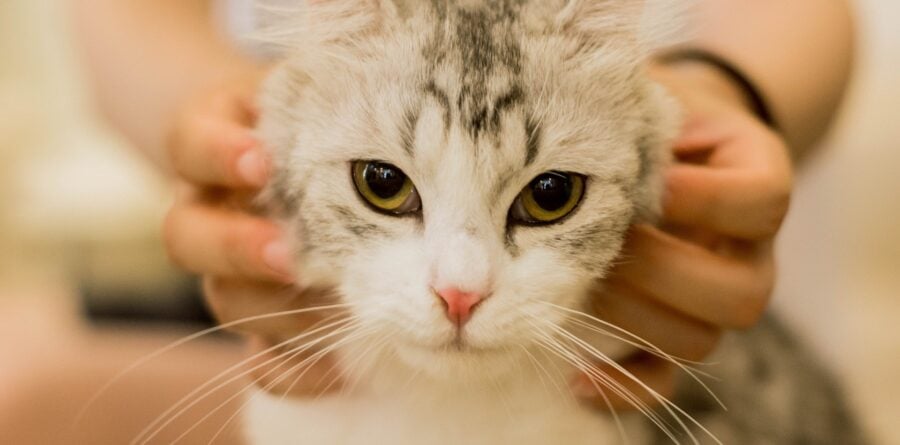6 simple at-home dog and cat health checks
19/04/2022 - National Pet Month

Being a pet owner is a big responsibility, as you have to keep your furry friend fed, watered, happy and healthy. And part of this is being able to do some simple checks on your cat or dog at home, so that you can be sure to keep them in the best of health. National Pet Month is the perfect time to remind yourself of these all-important checks, and perhaps learn of some new ones.
These checks include making sure that your pet’s eyes, nose, teeth, nails and skin are all in good condition, as well as checking for fleas. It’s advised to do these checks regularly, as many pets are very good at hiding when something is wrong. They often don’t want to bother their beloved humans, so it’s good to take a closer look to ensure that all is well with them.
Nose
Checking your pet’s nose is often an easy way to start their check-up. Their nose should be:
- Soft and moist
- Clear, with your dog or cat able to breathe easily
- Free from any snot or other kind of discharge
You’ll need to take them to the vet for a more detailed check-in if their nose:
- Has any snot or discharge on it
- Is obstructing their breathing
- Is cracked or dry.
Eyes
Both cats and dogs should have clear, healthy eyes, and there should be no discomfort exhibited by the animal in this area, such as itching and scratching their eyes with their paws or rubbing their face on the furniture regularly. Your pet’s eyes should:
- Be clear and bright
- Be free from tears or any kind of discharge
- Have a fleshy area around the eyeball (called the conjunctiva) that is salmon pink
You will need to take your animal to the vet if their eyes are:
- Looking sore or red in any way
- Weeping or exhibiting discharge
- Being held closed or squinting
Ears
It’s often easy to overlook that your pet’s ears need checking, as problems with the ears can often be more difficult to spot than issues with the eyes or nose. So, taking time to give your pet’s ears a more thorough look is a good measure to take. Your animal’s ears should be:
- Free of any bad smells
- Coloured pink inside
- Free from any earwax built up
- Neatly standing up or flat depending on the animal’s breed and ear type
Take your pet to the vet if their ears are:
- Swollen or uncomfortable-seeming
- Smelly or full of earwax
- Causing them to scratch or shake their head a lot
Coat
Your pet’s coat is often one of the first things that let you know there is a problem with their health. You will likely be used to how their specific coat should look, so use your judgement and take them to the vet if you feel something has changed unexpectedly. Your pet’s coat should be:
- Free from ticks, fleas, or other parasites
- Free from dry skin or dandruff
- Free from knots
- Free from bald patches
Take your furry friend to the vet if their coat:
- Becomes matted or knotted
- Shows signs of having fleas or ticks
- Shows signs of dandruff or flaky skin
Skin
Once you’ve examined your pet’s coat, you should take a closer look at their skin. While you might not be able to see it as easily, it’s important to make sure that it is healthy. Your pet is doing well if their skin is:
- Smooth, without signs of dryness
- Free from rashes and unexpected bumps
- Free from wounds, discharge or infections
Make sure to take your animal to the vet if their skin is:
- Sore, itchy or showing rashes
- Dry or flaky
- Moist or wet in certain areas
Teeth and gums
Most dogs and cats don’t enjoy having their teeth and gums examined, so you might have to coax them into letting you take a look inside their mouth. Doing this check regularly however will get your pet used to the experience, and you will hopefully find that it becomes easier each time. Your animal’s teeth and gums should be:
- Clean and white
- Not showing any missing teeth (except ones you know they’ve had removed)
- Free from stains, breaks or cracks
- Moist and flesh-coloured, and free from lumps and bumps
Make an appointment with your vet to examine or clean their teeth if they are:
- Missing any unexpected teeth
- Broken or showing cracks
- Stained or have a build-up of plaque
- Not the normal colour for their flesh, or showing signs of swelling
Chris Socratous, Senior Brand Manager at Bob Martin comments:
“Being able to do a few little checks at home can be a real asset in making sure that your pet is kept in good health. Over time, you’ll be able to spot things more easily when you examine your furry friend, and this can let you know when you should book an appointment with your vet.
“When conducting these at-home health checks, you should also take time to note your pet’s temperament. If they seem relaxed and comfortable following their usual routine, this is a good sign for their physical wellbeing, too. On the other hand fidgeting, anxious behaviour, or aversion to being touched in places they are usually happy to have contact can all be possible signs of underlying issues.
“As well as ensuring that you check your pet regularly for any issues, you should also make sure that you maintain a healthy diet and a good amount of exercise. You should also consider starting a regular flea and worming treatment to keep those pesky parasites at bay. This will help to keep your pet happy and feeling their best.”
For more information visit the National Pet Month website
All articles on this news site are submitted by registered contributors of SuffolkWire. Find out how to subscribe and submit your stories here »

